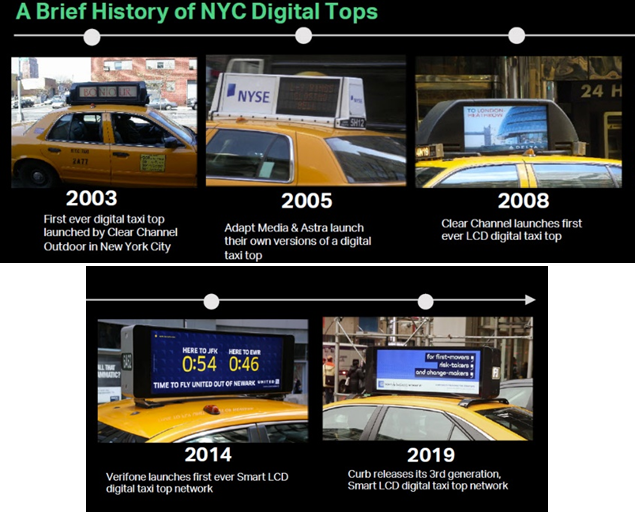Displays on Wheels: New Developments in Automotive Exterior Displays
The idea of attaching a sign or image to a vehicle probably dates back to some ancient Roman merchant who decorated his delivery wagon, but it wasn’t until the 21st century that exterior vehicle signage went digital. And now, the emergence of new technologies such as e-paper displays and smart glass have expanded the options for exterior automotive displays. In particular, the rise of autonomous vehicles is spurring a need for new communication mechanisms between the car and other vehicles and pedestrians around it.

A pre-digital example of vehicle exterior signage can be seen in this 1879 photo of a horse-drawn wagon owned by London’s Metropolitan Railway.
Mobile Billboards
The first electronic vehicle displays showed up on taxis, with panels installed on the taxi roof called “car tops” for obvious reasons. At first, they were very basic, consisting of a single printed panel with a backlight. The design then progressed to simple LED arrays that could show different messages in alphanumeric text, and then to LCD display panels.
In 2014, “smart” displays were introduced that could show dynamic images and video content. Today’s smart car-tops are integrated with more sophisticated controllers that can do “hyper targeting”—changing display content dynamically based on real-time triggers such as location, weather, and live events.
In the 21st century, digital car-top displays have become ubiquitous on taxis and other vehicles in New York City and around the globe. (Image Source)
Beyond the Roof: More Real Estate for Display Integrations
It didn’t take too long before businesses turned their attention to other parts of the vehicle’s exterior real estate. Display panels can be attached to the side, such as on city buses. These are typically LCD flat panels that can provide a relatively thin, lightweight, bright, and energy-efficient display that is also durable enough for outdoor use where it’s subject to both weather and the bumps and vibration of a moving vehicle. The side of a bus offers a large canvas for a display; yet even larger screen sizes can be achieved on trucks where entire side walls can become display screens.
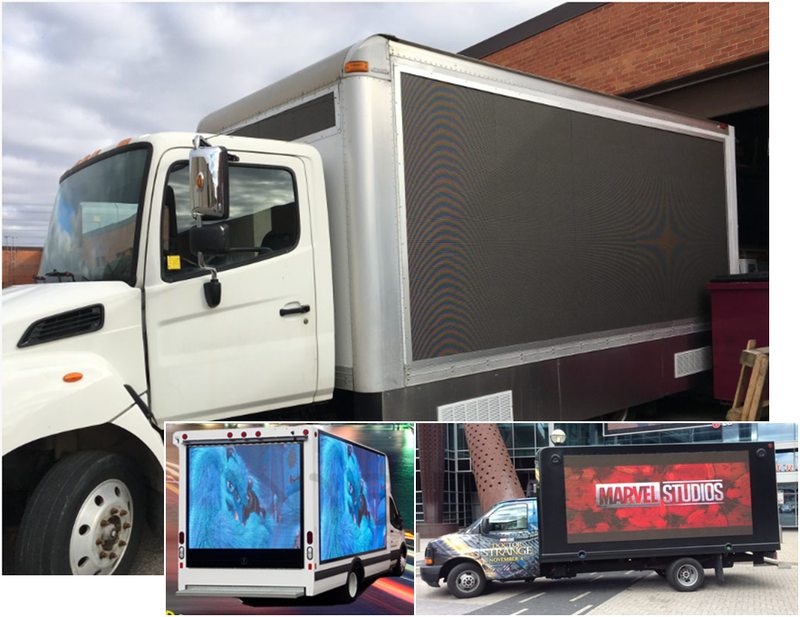
This truck provides a large LED canvas for displaying images or video. (Images © LEDLE Media)
One slight drawback with side display panels such as those on a city bus is that a viewer might only catch a glimpse of the display for a couple of seconds as the vehicle drives by. A car’s rear window, however, is directly in the field of view of any vehicle behind it in traffic or at a stoplight, providing more exposure time for any message or advertisement. Semi-transparent rear-window LED displays can take advantage of this placement while still allowing a driver some rear visibility.

Right, a large LED screen on a London double-decker bus. Left, a semi-transparent smart LED display panel in a car’s rear window, which can display a rotating series of images. (Right image © Technoframe, left image © NSE LED)
Autonomous Vehicle Displays
Consumer surveys show mixed reaction to the increasing use of vehicle displays for advertising and promotion, but there is broader acceptance for the idea of using exterior displays to communicate operating information.1 Developers of self-driving automotive technology have been exploring ways to increase pedestrian and traffic safety by displaying messages and information in real time on the vehicle exterior—a new realm of human-machine interfaces.
In a future road environment that may include traditional driver-controlled vehicles, pedestrians and cyclists, and semi- and fully autonomous vehicles, “advanced communication interfaces will need to be developed that inform pedestrians of the current state and future behavior of an autonomous vehicle, in order to maximize safety and efficiency for all road users.”2 Not surprisingly, where road safety is concerned, industry groups are already considering whether these displays and messages need standardization to reduce any viewer confusion.3
Demonstration of a Drive.ai driverless vehicle and displays.
Exploring New Display Technologies
With multiple new technologies to play with, automotive designers are getting more creative, and the industry has started to experiment with a variety of new exterior-display applications. For example:
Smart glass – Auto makers have begun to incorporate new smart glass (aka switchable glass) technology into their products. Basic applications include windows and sunroofs that darken to filter sunlight, but smart glass also offers the potential for every window of the vehicle to be turned into a dynamic display surface. And unlike LED window displays, smart glass can instantly be rendered fully transparent for unobstructed driver and passenger visibility.4
E-paper – Another technology with potential automotive applications is e-paper, aka electronic paper, electronic ink, e-ink, or electrophoretic display (EPD). As a reflective display type, e-paper uses very little power, requiring electrical input only to switch images. The State of California recently began testing e-paper displays for license plates—at $700 each they are only for custom/vanity plates currently. But their advantages include eliminating the need for stickers to update annual registration. And because the images can be switched, these plates may appeal to fleet managers to display advertising messages when the vehicle is stopped.
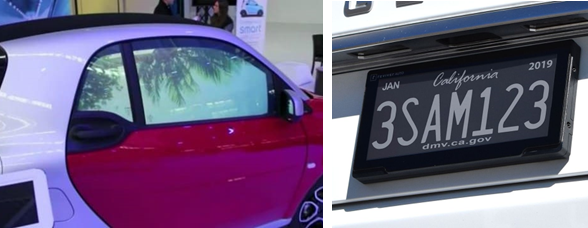
A prototype smart-glass window display from Gauzey (left) and an e-paper license plate in California (right). (Left image Source, right image Source)
Recently BMW has captured attention with its new color-changing concept car, the BMW iX Flow. Using e-paper technology provided by E Ink, the entire surface of the vehicle serves as a display. Millions of microcapsules containing negatively charged white pigments and positively charged dark pigments can be repositioned with an electric field to change color and create various gradients or patterns on the surface.
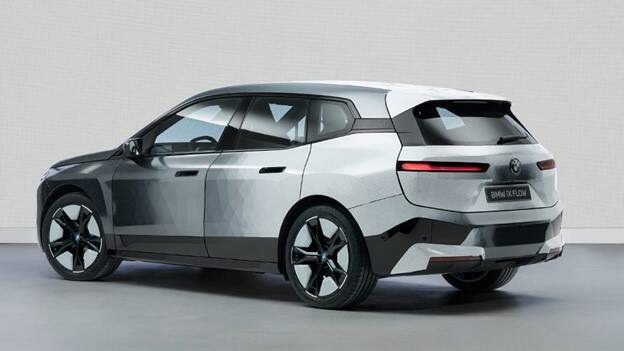
The BMW iX Flow shown here mid-transition between black and white exterior color. (Image Source)
Exterior Display Quality Considerations
For displays viewed outdoors, brightness is a key consideration to ensure visibility in ambient lighting conditions from full sun to night. Clarity and contrast are important for readability at various distances, while view angle performance is critical for visibility of displays seen off-angle—a likely viewing condition for “displays on wheels.” In tests of LED vehicle exterior displays, pixel pitch has proven to be a challenging parameter to perfect in order to optimize resolution for image clarity.
Emissive displays such as LED screens also require calibration to ensure brightness and color uniformity between each LED or pixel for high-quality images. Among its many advantages, e-paper offers clarity, contrast, and view angle performance, but may have limited applications initially due to slow image switching speed.
Whatever the display technology, Radiant’s 30 years of test and measurement experience—from outdoor LED screens to transparent displays and smart glass—cover any possible automotive integration. Radiant’s ProMetric® Imaging Photometers and Colorimeters capture a full field of view of the measurement area to provide comprehensive brightness and color data for evaluating millions of pixels in a matter of seconds. Used with our advanced TrueTest™ analysis software, automakers can efficiently characterize all important visual criteria in a display at once.
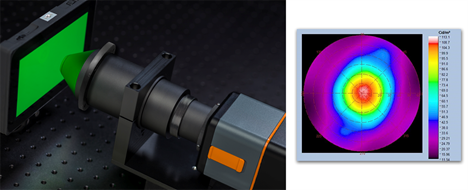
Radiant's ProMetric Imaging Photometer with our FPD Conoscope Lens can characterize the view-angle performance of displays.
Special optical filters and calibrations ensure that light measurement by ProMetric systems is weighted against CIE functions describing the standard human visual response. Optionally, ProMetric imaging systems can be paired with unique lenses such as our FPD Conoscope Lens for fast, accurate, and complete display view angle performance data in a single measurement to ±70 degrees. Radiant’s solutions ensure every display is evaluated according to how its brightness, color, and quality is perceived by those both inside and outside the vehicle. As the automotive display industry continues to innovate, Radiant keeps evolving to meet new visual inspection needs.
CITATIONS
- Ashley Colley, Jonna Hakkila, et al., “Car Exterior Surface Displays: Exploration in a Real-World Context.” PerDis’18: Proceedings of the 7th ACM International Symposium on Pervasive Displays, June 2018, Article 7, pp 1-8. doi.org/10.1145/3205873.3205880
- Alexandros Rouchitsas and Håken Alm, “External Human-Machine Interfaces for Autonomous Vehicle-to-Pedestrian Communication: A Review of Empirical Work.” Frontiers in Psychology, December 10, 2019. doi.org/10.3389/fpsyg.2019.02757
- Brian Watson, “Will Connected and Autonomous Vehicles change the landscape of signage standardization?” June 19, 2019
- “4 Ways Automotive Glass Technologies Are Transforming the Industry.” Gauzey, September 18, 2019. (Retrieved June 10, 2022)
Join Mailing List
Stay up to date on our latest products, blog content, and events.
Join our Mailing List
